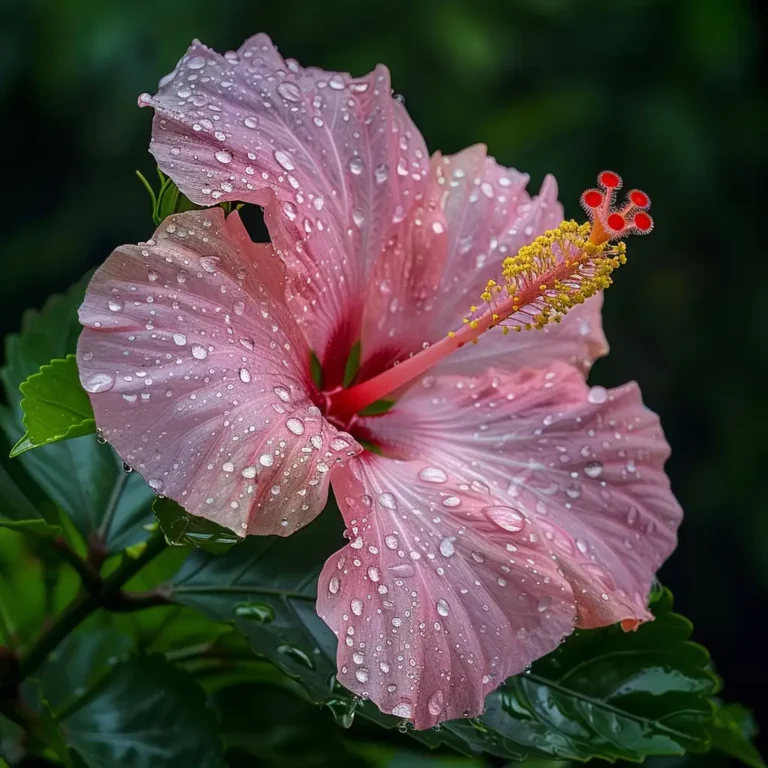Introduction to Dew-Kissed Hibiscus
The hibiscus is a vibrant, eye-catching flower known for its large, colorful blooms. When touched by the morning dew, these flowers take on a magical quality, appearing even more enchanting. This article explores the beauty and significance of dew-kissed hibiscus, along with tips for cultivation, photography, and more.
The Science Behind Dew and Hibiscus
Morning dew forms when atmospheric moisture condenses on cool surfaces. For hibiscus flowers, this dew can enhance their visual appeal and provide certain biological benefits. The presence of dew can help maintain the plant’s hydration, especially in early morning hours when the air is still cool.
Varieties of Hibiscus
Hibiscus flowers come in a wide array of species and colors, each with unique characteristics. Varieties such as Hibiscus rosa-sinensis thrive in dewy conditions, displaying vibrant reds, pinks, and whites. Identifying the right variety for your garden can enhance its beauty and ensure healthy growth.
Cultivating Hibiscus in Your Garden
To cultivate hibiscus successfully, consider the following tips:
- Soil: Well-drained soil rich in organic matter.
- Sunlight: Full sun to partial shade.
- Watering: Regular watering, but avoid waterlogging.
Encourage dew formation by watering in the early morning or late evening, allowing the moisture to settle overnight. Seasonal care, including pruning and fertilizing, will keep your plants healthy and blooming.
Photographing Dew-Kissed Hibiscus
Capturing the beauty of dew-kissed hibiscus requires some basic photography techniques:
- Timing: Early morning when dew is freshest.
- Equipment: Use a macro lens to get close-up shots.
- Lighting: Natural light works best; avoid harsh midday sun.
These tips will help you take stunning photos of your hibiscus flowers, showcasing their dewy charm.
Symbolism and Cultural Significance
Hibiscus flowers hold various symbolic meanings across cultures. They often represent beauty, grace, and delicate femininity. In some traditions, they symbolize new beginnings and purity, especially when adorned with morning dew. These flowers are also frequently used in art and literature to convey freshness and vitality.
Hibiscus in Culinary and Medicinal Uses
Certain varieties of hibiscus are edible and used in various culinary dishes. The flowers can be used to make teas, jams, and salads. They also have medicinal properties, such as:
- Antioxidants: Rich in vitamins and minerals.
- Anti-inflammatory: Helps reduce inflammation.
- Digestive Aid: Promotes healthy digestion.
Common Pests and Diseases
Protect your hibiscus from common pests and diseases:
- Aphids: Can be controlled with insecticidal soap.
- Spider Mites: Mitigated by maintaining high humidity.
- Fungal Diseases: Prevented through proper watering and air circulation.
Using organic solutions can help manage these issues without harming your plants or the environment.
FAQs
What are the best conditions for hibiscus to thrive?
Hibiscus plants thrive in well-drained soil, full sun, and with regular watering. Ensure the soil is rich in organic matter for optimal growth.
How does dew benefit hibiscus flowers?
Dew provides early morning hydration, helping to maintain moisture levels and enhance the flower’s visual appeal.
Can hibiscus grow indoors?
Yes, hibiscus can be grown indoors with sufficient sunlight and proper care. Ensure they receive adequate light and are protected from drafts.
Conclusion
In summary, the dew-kissed hibiscus is a captivating flower that brings beauty and elegance to any garden. By understanding its needs and characteristics, you can cultivate and appreciate these flowers to their fullest. Whether you’re a gardener, photographer, or simply a flower enthusiast, the dew-kissed hibiscus offers endless enjoyment and inspiration.

